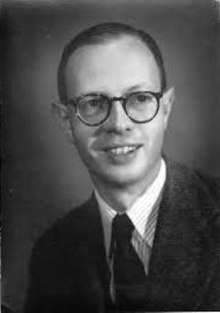Loading AI tools
American statistician (1917–2009) From Wikipedia, the free encyclopedia
Erich Leo Lehmann (20 November 1917 – 12 September 2009) was a German-born American statistician, who made a major contribution to nonparametric hypothesis testing.[1] He is one of the eponyms of the Lehmann–Scheffé theorem and of the Hodges–Lehmann estimator of the median of a population.
This article needs additional citations for verification. (March 2013) |
Erich Lehmann | |
|---|---|
 | |
| Born | 20 November 1917 |
| Died | 12 September 2009 (aged 91) |
| Nationality | American |
| Alma mater | Doctor of Philosophy - University of California, Berkeley |
| Known for | Testing Statistical Hypotheses Completeness (statistics) Lehmann–Scheffé theorem Hodges–Lehmann estimator nonparametric tests |
| Awards | President of the Institute of Mathematical Statistics Fellow of the American Statistical Association American Academy of Arts and Sciences National Academy of Sciences. |
| Scientific career | |
| Fields | Statistics |
| Institutions | University of California, Berkeley |
| Doctoral advisor | Jerzy Neyman |
| Doctoral students | Peter J. Bickel Allan Birnbaum David Draper Madan Lal Puri Frank Hampel |
Lehmann was born in Strasbourg, Alsace-Lorraine in 1917 to a family of Ashkenazi Jewish ancestry. He grew up in Frankfurt am Main, Germany, until the Machtergreifung in 1933, when his family fled to Switzerland to escape the Nazis.[1] He graduated from high school in Zurich, and studied mathematics for two years at Trinity College, Cambridge. Following that, he emigrated to the United States, arriving in New York in late 1940. He enrolled in University of California, Berkeley as a post-graduate student—albeit without a prior degree—in 1941.[2]
Lehmann obtained his MA in mathematics in 1942 and his PhD (under Jerzy Neyman) in 1946, at the University of California, Berkeley, where he taught from 1942.[2] From August 1944 to August 1945 he worked as an operations analyst for the United States Air Force on Guam.[2] He taught at Columbia University and at Princeton University during 1950–51, and then during 1951–1952 he was a visiting associate professor at Stanford University.
He was an editor of the Annals of Mathematical Statistics and president of the Institute of Mathematical Statistics, and a member of the American Academy of Arts and Sciences and the National Academy of Sciences.
In 1977 he married another statistician, Juliet Popper Shaffer, whom he had met four years earlier as the sponsor to her sabbatical visit to Berkeley. In the same year, Shaffer moved from being a psychology professor at the University of Kansas to a lecturer position in statistics at Berkeley.[3]
In 1997, on the occasion of his eightieth birthday, the department of statistics at the University of California at Berkeley created the Erich Lehmann Fund in Statistics[4] to support the students of the department.
Seamless Wikipedia browsing. On steroids.
Every time you click a link to Wikipedia, Wiktionary or Wikiquote in your browser's search results, it will show the modern Wikiwand interface.
Wikiwand extension is a five stars, simple, with minimum permission required to keep your browsing private, safe and transparent.